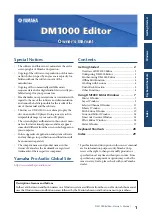
If I choose to create a log file, what kind of information does the log file contain?
There are two types of log files that can be generated that monitor information about deployments and
installations.
■
The Network log file keeps a record of all workstations that run the deployment. The log lists the user name,
workstation name, and the status of the installation. Refer to this file for status information and details about
problems that users may have encountered during installation.
■
The Client log file contains detailed installation information for each workstation. This information may be
useful in diagnosing installation problems. The client log is located in the
\Temp
directory of each client
workstation.
What is an administrative image (MSI) file?
An
administrative image
is a collection of shared file resources created during the deployment process and is used
by deployments to install the program to networked workstations. An
.msi
file is a Microsoft Installer file.
What is the impact of selecting all products to be included in the administrative
image?
If you elect to include all products in your deployment, the administrative image will be larger.
You should select all products only when you create multiple deployments from this image and prefer not to
use the installation disk. If there are products you rarely or never use, and you do not expect to create additional
deployments, you should only select a subset of products.
You can still create a deployment at a later date, and include additional products, but you need to create a new
administrative image. You need the installation media to do so.
Uninstall and Maintenance Issues
This section outlines common issues and their solutions with regards to adding and removing features, reinstalling
or repairing your installation, and uninstalling products.
When adding or removing features, how can I tell what features get installed
by default?
To quickly see what gets installed during a typical, default installation, click the Restore Defaults button on the
Add/Remove Features page.
Is it possible to change the installation folder when adding or removing
features?
Once your product is installed, you cannot change the installation path from the Add/Remove Features page.
Changing the path while adding features results in program corruption, so it is not an option.
When should I reinstall the product instead of a repair?
You should reinstall your product if you accidentally delete or alter files that are required by the program. Missing
or altered files adversely affect the performance of your product and cause error messages when you try to execute
a command or find a file.
If an attempt to repair an installation fails, reinstalling is the next best option.
50 | Chapter 3 Installation
Summary of Contents for 507B1-90A211-1301 - NavisWorks Manage 2010
Page 1: ...Autodesk Navisworks Manage 2010 User Guide March 2009 ...
Page 12: ...xii Contents ...
Page 14: ...2 Part 1 Welcome to Autodesk Navisworks Manage 2010 ...
Page 64: ...52 Chapter 3 Installation ...
Page 97: ...Get a Whole Project View 85 ...
Page 98: ...86 Part 2 Get a Whole Project View ...
Page 136: ...124 Chapter 5 Work with Files ...
Page 178: ...To toggle ViewCube Click View Head Up Display ViewCube 166 Chapter 6 Explore Your Model ...
Page 262: ...250 Chapter 9 Use Viewpoints and Sectioning Modes ...
Page 270: ...258 Chapter 11 Work Within a Team ...
Page 282: ...270 Chapter 12 Share Data ...
Page 346: ...334 Chapter 14 Create Photorealistic Visualizations ...
Page 460: ...448 Chapter 17 Autodesk Navisworks Reference ...
Page 466: ...454 Glossary ...
















































